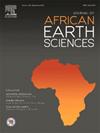古新生代花岗岩与 Dibilo(西非克拉通尼日尔西部 Liptako)稀有元素伟晶岩之间的成岩关系
IF 2.2
4区 地球科学
Q2 GEOSCIENCES, MULTIDISCIPLINARY
引用次数: 0
摘要
迪比洛稀有元素伟晶岩形成于距尼日尔利普塔科(西非克拉通马恩海脊东北部)与迪亚哥鲁-达尔巴尼绿岩带接触带约 4 公里处的古新生代 Téra-Ayorou 岩体中的色质片麻岩的侵入体。本研究的总体目标是通过结合岩石学、地球化学、构造地质学和成矿学的多学科方法,确定花岗岩和迪比洛伟晶岩之间的岩石成因关系。迪比洛的花岗岩分为两代。第一代金属铝至弱过铝花岗岩(黑云母片麻岩、透辉石和双云母花岗片麻岩)构成了钙碱性系列。微量元素地球化学特征表明,这些花岗岩是在岛弧和俯冲带背景下形成的。第二代花岗岩(白花岗岩)包括双云母花岗岩、蕈云母花岗岩和双云母石榴石花岗岩,均为过铝和钙碱性。这些白花岗岩是肥沃的,即富含不相容元素,最富含的锂浓度达到 250 ppm。局部熔融模型显示,它们可能来自富锂偏闪长岩的局部熔融,而偏闪长岩本身就富含锂(150 ppm)。有一个伟晶岩样本的锂含量达到了百万分之 300,这证明了辉绿岩-闪长岩-花岗岩片麻岩复合体的肥沃性质。在迪比洛发现了三种类型的伟晶岩:不育伟晶岩(I 型),过铝,演化程度低;铌钽伟晶岩(II-a 型)和铌钽、钼伟晶岩(II-b 型),中度演化,过铝,分别含有铌铁矿族矿物(II-a 型)和铌铁矿族矿物及含钼硫化物(II-b 型);以及高度演化、过铝的锂和铌钽伟晶岩(III 型),矿化物为闪锌矿和铌铁矿族矿物。I 型贫瘠伟晶岩与白榴石有相似之处,也可能源自闪长岩片麻岩的部分熔融。高度演化的Ⅱ-a型、Ⅱ-b型和Ⅲ型伟晶岩与白榴石部分结晶产生的残留液体相对应。因此,我们认为,迪比洛稀有元素伟晶岩源于辉绿岩-闪长岩-花岗岩复合体中的碎裂结晶和部分熔融过程。本文章由计算机程序翻译,如有差异,请以英文原文为准。
Petrogenetic relationships between Paleoproterozoic granitoids and rare-element pegmatites from Dibilo (Liptako, West Niger, West African Craton)
The rare-element pegmatites of Dibilo form intrusions in a tonalitic gneiss of the Paleoproterozoic Téra-Ayorou pluton about 4 km from the contact zone with the Diagorou-Darbani greenstone belt, in the Nigerien Liptako (NE portion of the Man Ridge of the West African Craton). The general objective of the present study is to determine the petrogenetic relationships between the granitoids and the Dibilo pegmatites through a multidisciplinary approach combining petrology, geochemistry, structural geology and metallogeny. Two generations of granitoids have been distinguished at Dibilo. A first generation of metaluminous to weakly peraluminous granitoids (tonalitic gneiss, metadiorite and two-mica granitic gneiss) constitute a calc-alkaline series. Trace element geochemical signatures suggest that these granitoids were emplaced in an island arc and subduction zone context. A second generation of granitoids (leucogranites), encompassing two-mica, muscovite and two-mica-garnet granites, are peraluminous and calc-alkaline. These leucogranites are fertile, i.e., rich in incompatible elements, with Li concentrations attaining 250 ppm in the richest. A model of partial melting shows that they could derive from the partial melting of Li-rich metadiorite, which is itself highly enriched in lithium (150 ppm). One sample of migmatite has Li contents of 300 ppm, which evidences the fertile nature of the tonalitic-dioritic-granitic gneiss complex.
Three types of pegmatite have been identified at Dibilo: sterile pegmatites (type I), peraluminous and poorly evolved; Nb-Ta pegmatites (type II-a) and Nb-Ta, Mo pegmatites (type II-b), moderately evolved, peraluminous, respectively mineralized with columbite-group minerals (type II-a) and columbite-group minerals and Mo-bearing sulfide (type II-b); and highly evolved, peraluminous Li and Nb-Ta pegmatites (type III) mineralized with spodumene and columbite-group minerals. The type I barren pegmatites share similarities with the leucogranites and could also originate from the partial melting of the dioritic gneiss. The highly evolved type II-a, type II-b and type III pegmatites correspond to the residual liquids resulting from the fractional crystallization of leucogranites. Therefore, we propose that the Dibilo rare-element pegmatites derive from both fractional crystallization and partial melting processes within the tonalitic-dioritic-granitic complex.
求助全文
通过发布文献求助,成功后即可免费获取论文全文。
去求助
来源期刊

Journal of African Earth Sciences
地学-地球科学综合
CiteScore
4.70
自引率
4.30%
发文量
240
审稿时长
12 months
期刊介绍:
The Journal of African Earth Sciences sees itself as the prime geological journal for all aspects of the Earth Sciences about the African plate. Papers dealing with peripheral areas are welcome if they demonstrate a tight link with Africa.
The Journal publishes high quality, peer-reviewed scientific papers. It is devoted primarily to research papers but short communications relating to new developments of broad interest, reviews and book reviews will also be considered. Papers must have international appeal and should present work of more regional than local significance and dealing with well identified and justified scientific questions. Specialised technical papers, analytical or exploration reports must be avoided. Papers on applied geology should preferably be linked to such core disciplines and must be addressed to a more general geoscientific audience.
 求助内容:
求助内容: 应助结果提醒方式:
应助结果提醒方式:


